Despite its small size, the Bedlington Terrier is a breed that shouldn't be underestimated.
While some may argue that its energetic nature and high intelligence can be challenging to handle, those qualities actually make it an ideal companion for individuals or families looking for an active and engaging pet.
From its origins as a poaching dog to its role as a watchdog, the Bedlington Terrier has proven itself to be a loyal and protective companion.
In this article, we will explore the various aspects of this breed's temperament, exercise needs, and care requirements, shedding light on why it is indeed an energetic and intelligent companion worth considering.
Key Takeaways
- Bedlington Terriers are medium-sized dogs that originated in England and were used for poaching game.
- They are alert, energetic, and intelligent, making them excellent companions and watchdogs.
- Bedlington Terriers may be aggressive towards dogs of the same sex and have a tendency to chase small furry animals.
- Regular veterinary check-ups are crucial for this breed, as they are prone to certain health conditions such as liver problems, kidney disease, and genetic conditions.
Origin and History
The Bedlington Terrier has a fascinating origin and history, originating in England and gaining attention from local squires. Developed in the north of England, this breed is believed to have traveled with Rom, or gypsies, and was used for poaching game.
It was named after Bedlington in Northumberland, where it gained popularity among the local gentry. Males stand 16 inches at the shoulder, while females stand 15 inches. Despite its medium size, the Bedlington Terrier is suitable for both apartments and houses.
Known for being alert, energetic, and intelligent, it makes an excellent companion and watchdog. However, it can be aggressive towards same-sex dogs and has a tendency to chase small furry animals. Regular veterinary check-ups are crucial for this generally healthy breed, as it's prone to certain health conditions such as liver problems, kidney disease, and genetic conditions.
It requires regular exercise and a safely fenced area, but isn't suited for living outdoors. With its intelligence and moderate ease of training, the Bedlington Terrier is an ideal choice for those looking for an energetic and intelligent companion.
Physical Characteristics
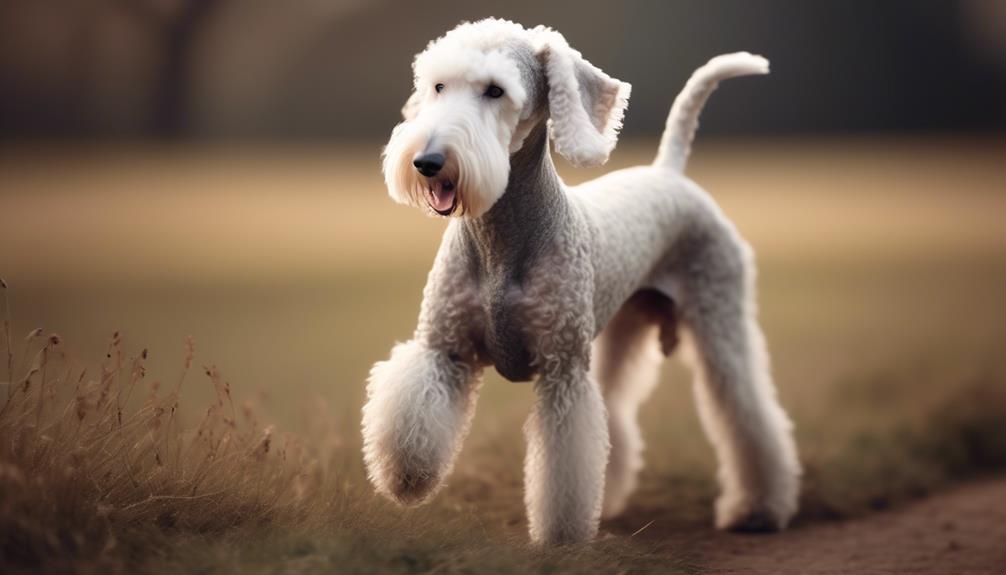
Originating in England and gaining attention from local squires, the Bedlington Terrier has a fascinating history that sets the stage for its unique physical characteristics.
This medium-sized breed stands at around 16 inches for males and 15 inches for females at the shoulder. With a weight range of 17-23 pounds, the Bedlington Terrier is known for its distinct coat, which is a combination of harsh and soft hair. The coat tends to curl, particularly on the head and face, giving the dog a distinctive appearance.
Bedlington Terriers come in various colors, including blue, sandy, liver, and bi-colors. Regular combing is necessary to maintain the coat, although it doesn't need to be stripped. Additionally, the face requires hand-scissoring for that unique Bedlington look.
Living Arrangements
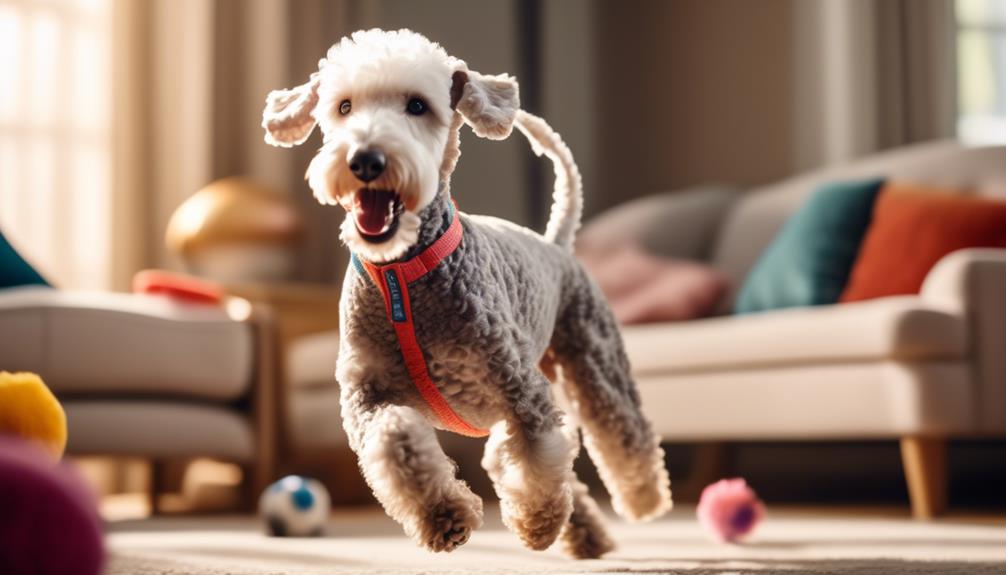
When it comes to living arrangements, the Bedlington Terrier is a versatile breed that can adapt well to various environments. Whether in an apartment or a house, this breed can thrive as long as their exercise needs are met.
While they're suitable for apartments, it's essential to consider the comfort of neighbors, as the Bedlington Terrier can be vocal if not properly trained. Additionally, providing a safely fenced area for exercise is crucial, as they've moderate activity levels and require regular physical activity to stay healthy and happy.
Although they aren't suited for living outdoors, they can still be appropriate for apartments as long as they receive sufficient exercise. With their intelligence and moderate trainability, the Bedlington Terrier can adapt well to different living arrangements with the right care and attention.
Health Considerations
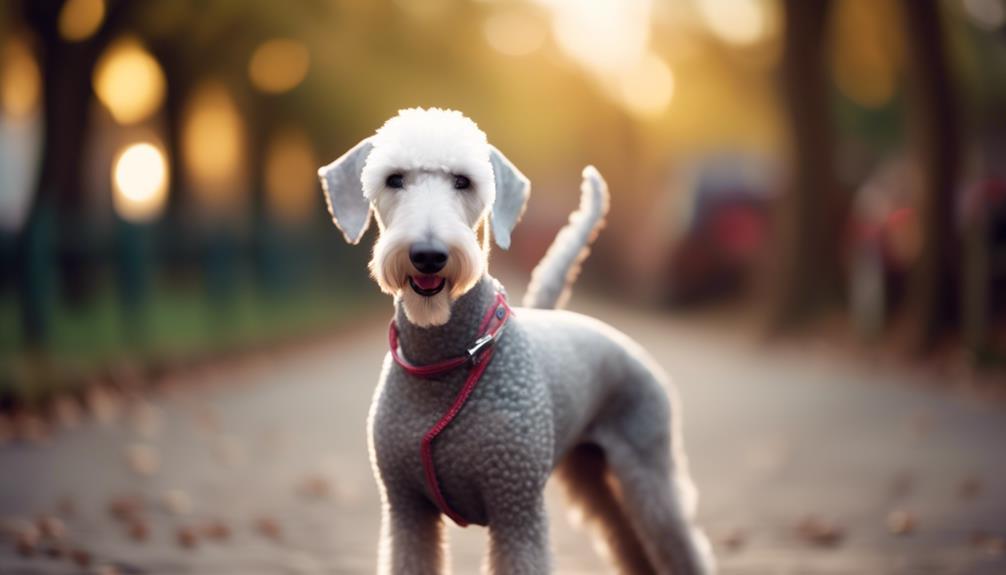
With regular veterinary check-ups being crucial, the Bedlington Terrier requires attentive care due to its potential health issues.
While generally a healthy breed, there are certain conditions that Bedlington Terriers may be prone to. One of these is liver problems, which can range from mild to severe. Kidney disease is another health concern to watch out for, as it can affect the overall well-being of the dog.
Additionally, Bedlington Terriers may be predisposed to certain genetic conditions, such as copper toxicosis and retinal dysplasia. It's important for owners to obtain health clearances from reputable breeders to ensure the health of their Bedlington Terrier.
Feeding and Grooming
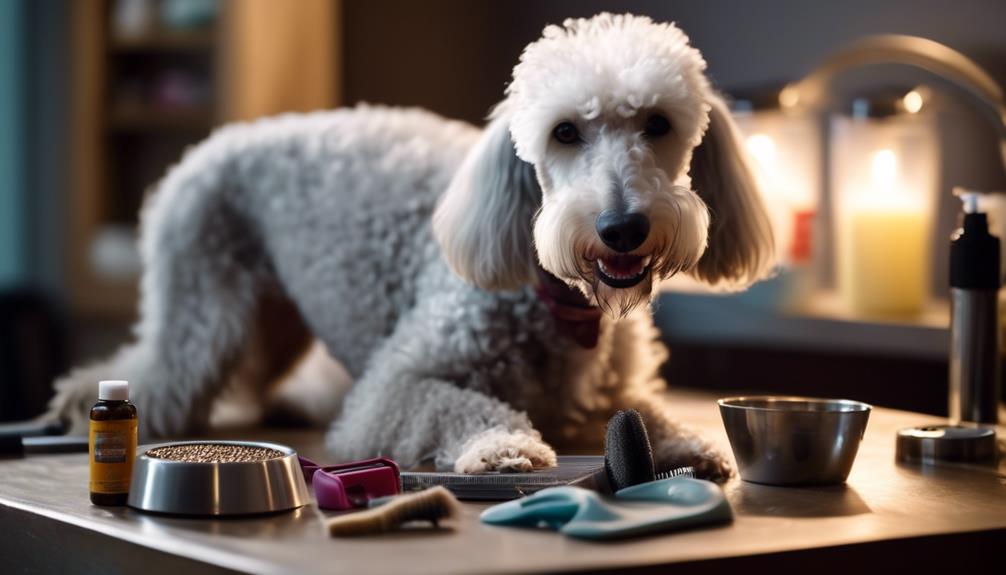
Feeding and grooming the Bedlington Terrier is essential for maintaining their health and appearance.
When it comes to feeding, it's recommended to provide them with 1 to 1.5 cups of high-quality dry food per day, divided into two meals. The amount of food needed depends on factors such as size, age, metabolism, and activity level. It's important to measure the food and feed them twice a day to keep them in good shape.
As for grooming, the Bedlington Terrier has a unique coat that's a combination of harsh and soft hair. While their coat doesn't need to be stripped, regular combing is necessary, especially since their coat tends to curl, especially on the head and face. Additionally, their face must be hand-scissored for a unique appearance.
Taking care of their feeding and grooming needs will ensure that the Bedlington Terrier stays healthy and looks their best.
Temperament and Socialization
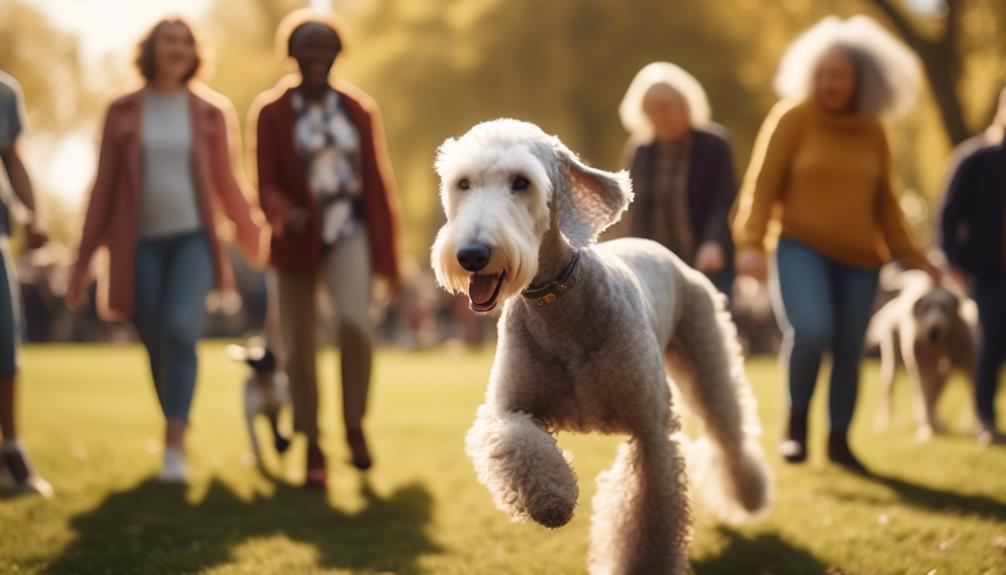
The Bedlington Terrier is known for its energetic and intelligent temperament, making it an excellent companion and watchdog. Here are three important points to consider about the Bedlington Terrier's temperament and socialization:
- Energetic Playmate: The Bedlington Terrier can be a lively and energetic playmate for children. However, it's best suited for homes with older children who understand how to approach and touch dogs. It's important to always supervise interactions between dogs and young children to ensure their safety.
- Aggression Towards Dogs: While the Bedlington Terrier can get along with other dogs if raised with them, it may display aggression towards dogs of the same sex. This is an important factor to consider when introducing a Bedlington Terrier to a household with other dogs.
- Adoption and Rescue: If you're interested in adopting a Bedlington Terrier, the national breed club and nationwide adoption databases can be valuable resources. The Bedlington Terrier Club of America and Adopt a Pet (Rescue Database) are great places to start your search for a Bedlington Terrier in need of a loving home.
Apartment Living and Suitability
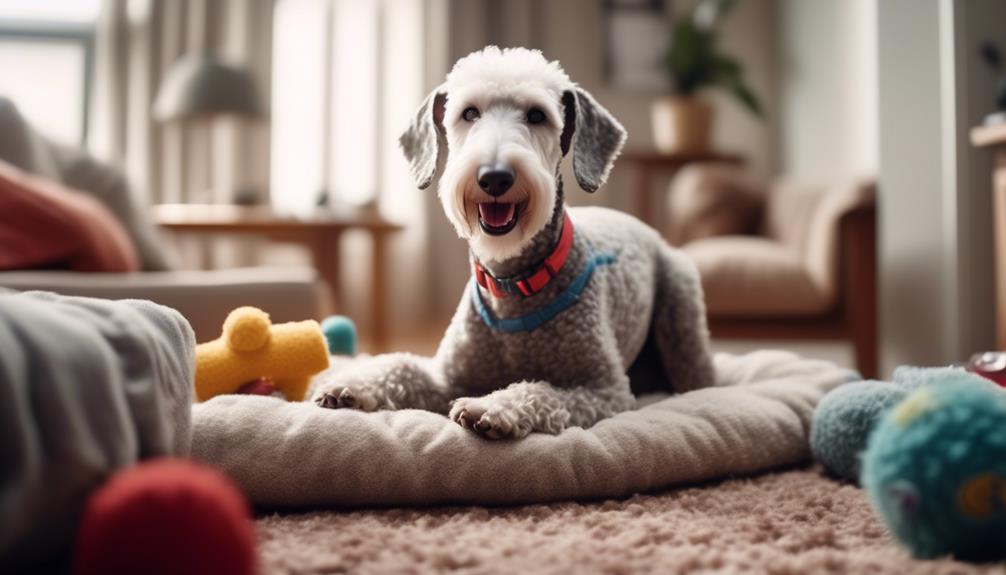
Apartment dwellers looking for a suitable canine companion will find the Bedlington Terrier to be a great choice. This breed adapts well to apartment living, making it an ideal pet for those in smaller living spaces. While size isn't the only factor to consider when selecting a dog for an apartment, the Bedlington Terrier's small stature is certainly an advantage.
However, it's important to prioritize qualities beyond size, such as being quiet, low-energy, calm indoors, and exhibiting good manners. The Bedlington Terrier checks all these boxes, making it an excellent fit for apartment living. Additionally, this breed is intelligent and moderately easy to train, further enhancing its suitability for apartment dwellers.
Dog Behavior and Exercise Needs
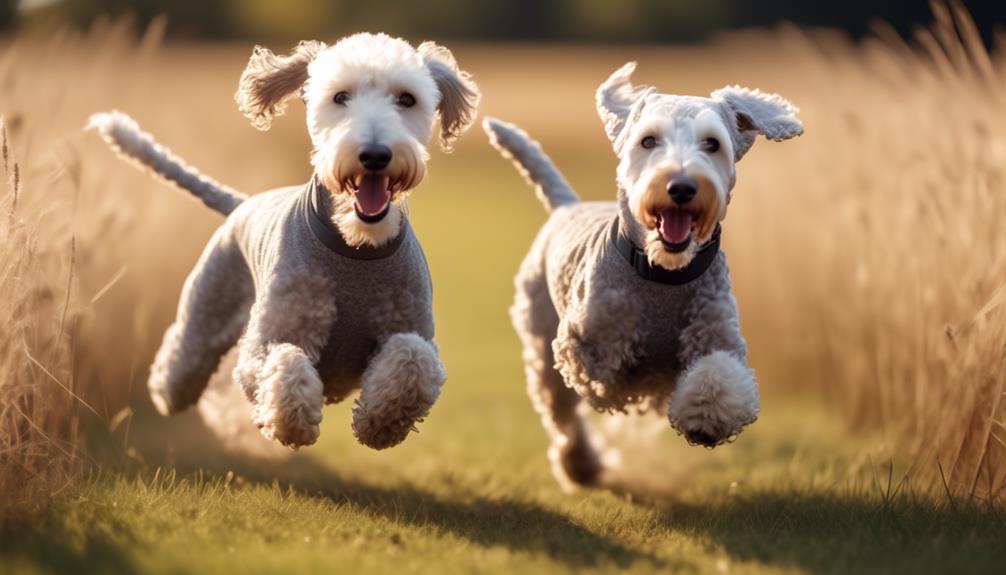
After discussing the suitability of the Bedlington Terrier for apartment living, it's important to understand the dog's behavior and exercise needs.
- Aggression in dogs is often rooted in fear and anxiety, which can result in disastrous consequences. Some dogs may exhibit aggression due to their predatory instincts, which should be observed separately from their prey drive. Certain breeds are more prone to barking or howling, so it's crucial to consider the frequency of vocalizations when choosing a breed. Dogs also vary in their tendency to wander, with some breeds having a stronger instinct to roam long distances.
- Dogs have different energy levels and exercise requirements. High-energy dogs require significant exercise and mental stimulation, while low-energy dogs are more relaxed and require less exercise. It's important to consider your own activity level and lifestyle when choosing a breed.
- Dogs also vary in their playfulness levels, with some always ready for a game and others having a more serious temperament. Consider the amount of playtime you can provide and whether you have kids or other dogs as playmates when choosing a breed.
Playfulness and Interaction
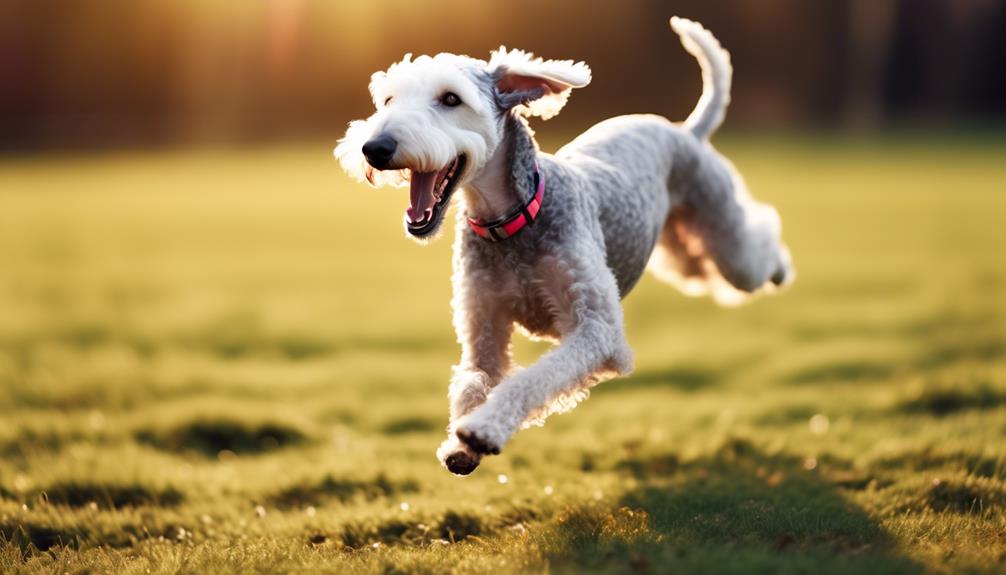
Playfulness and interaction are important aspects to consider when choosing a dog breed. Bedlington Terriers are known for their playful and energetic nature, making them great companions for active individuals or families. They thrive on engaging activities and enjoy spending time with their human companions. Bedlington Terriers are always ready for a game and can keep up with the energy levels of children or other dogs. However, it is important to note that their playfulness should be channeled in a positive and controlled manner to prevent any accidents or injuries. Regular interaction and playtime are essential for their mental and physical well-being. Below is a table highlighting the playfulness and interaction needs of Bedlington Terriers:
| Playfulness Level | Interaction Needs |
|---|---|
| High | Regular |
| Energetic | Positive |
| Engaging | Controlled |
| Enjoyable | Playtime |
Frequently Asked Questions
How Much Exercise Does a Bedlington Terrier Need?
A Bedlington Terrier needs regular exercise to stay healthy and happy. They enjoy activities like brisk walks, playtime in a safely fenced area, and mentally stimulating games. Aim for at least 30-60 minutes of exercise daily.
Are Bedlington Terriers Prone to Separation Anxiety?
Bedlington Terriers can be prone to separation anxiety. It is important for owners to provide them with plenty of mental and physical stimulation, as well as gradually acclimating them to being alone to help prevent this issue.
Can Bedlington Terriers Be Trained to Do Tricks?
Bedlington Terriers can be trained to do tricks! Their energetic and intelligent nature makes them quick learners. With consistent training and positive reinforcement, these charming dogs are sure to impress with their repertoire of tricks.
Are Bedlington Terriers Good With Cats?
Bedlington Terriers can be good with cats if properly socialized and introduced at a young age. However, it is important to monitor their interactions, as some Bedlington Terriers may have a strong prey drive towards small animals.
Do Bedlington Terriers Shed a Lot?
Yes, Bedlington Terriers do shed, but not a lot. Their coat is a combination of harsh and soft hair that tends to curl. Regular combing is necessary to prevent matting and maintain their unique appearance.
Are Bichon Frise also Energetic and Intelligent Companions like Bedlington Terriers?
Yes, like Bedlington Terriers, adorable playful Bichon Frise are also energetic and intelligent companions. They are known for their lively and friendly personalities, and their intelligence makes them easy to train. Bichon Frise can be a delightful addition to any family with their lively nature and affectionate temperament.
Conclusion
In conclusion, the Bedlington Terrier is a lively and intelligent companion that brings joy to any home.
With its energetic nature, this breed is always ready for playtime and exercise.
While it does have a tendency to be aggressive towards same-sex dogs and chase small animals, with proper training and socialization, these behaviors can be managed.
The Bedlington Terrier's unique appearance and charming personality make it a delightful addition to any family.




